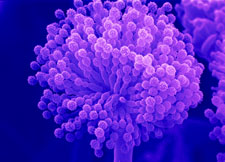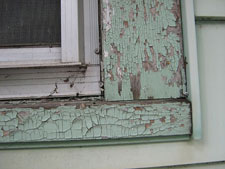Do you think there may be issues with the indoor air quality of your office or your home?
If you suspect there may be mold, asbestos, lead, VOCs or other issues, it is always best to inspect for any problems before it gets too bad. Green Shell can inspect your building, answer any questions and suggest solutions to just about any issues with your environment.
Below is background on some common environmental issues in the home or office, and why it is important to call Green Shell Consulting today.
Mold
Exposure to fungal bioaerosols in indoor air has emerged as a significant health problem in residential environments and in occupational settings such as offices, enclosed areas and industrial sites.  Mold and mildew are names given to thousands of species of filamentous fungi. The molds have clusters of spores which are located on the ends of tiny stalks. The spores are the reproductive product of the mature mold. Mold and mildew are names given to thousands of species of filamentous fungi. The molds have clusters of spores which are located on the ends of tiny stalks. The spores are the reproductive product of the mature mold.
The web-like body, or mycelium, attaches to porous surfaces. Mycelia and spores may contain chemical compounds some of which can be poisonous and toxic to humans and can create a large range of health problems depending on the exposure and tolerance of the individual. Spores pose a larger health concern because they become airborne and can be inhaled. The health related problems associated with exposure to mold and mildew range from allergic reactions, to respiratory tract inflammation and infection.
Neither bacteria nor fungi grow in the air. They originate on surfaces or in substrates. Molds live in conditions of wide ranges of temperature but need moisture as well as a food source to thrive. Many home and office building materials, such as wood, acoustical ceiling tiles, carpets, wallboard, wallpaper, soiled fiberglass A/C ducts, filters and insulation are well known substrates for bacterial and/or fungal growth when they become wet or retain moisture. Water staining or other discoloration are typical signs of bacterial and/or fungal growth, however, these signs are not always apparent.
Green Shell’s team of expert Licensed Mold Assessors will identify mold problems and develop a remediation protocol to correct the problem. These protocols may include building alterations to help prevent future mold issues. Initial testing, remediation supervision and post-remediation clearance testing are among the services provided.
Asbestos
Asbestos is a mineral fiber which is mined from the earth that has been used commonly in a variety of building construction materials for insulation, acoustical, decorative purposes and as a fire-retardant. Other places where asbestos was used are brake pads, clutch facings and gaskets on cars, however, asbestos has been mined for hundreds of uses.
 When asbestos fibers are released into the air, their microscopic size allows them to remain airborne for extremely long periods of time. This is a potential health problem since inhaling asbestos fibers has been known to cause respiratory problems and cancer. Asbestos was used in various building materials from about 1910 to the present time. When asbestos fibers are released into the air, their microscopic size allows them to remain airborne for extremely long periods of time. This is a potential health problem since inhaling asbestos fibers has been known to cause respiratory problems and cancer. Asbestos was used in various building materials from about 1910 to the present time.
Only materials such as wood, plastic, metal and glass have no potential to contain asbestos. Other materials at least have a potential, so caution must be taken to avoid disturbing other materials until they have been proven not to contain the mineral.
Green Shell can inspect your property and collect either bulk or air samples to determine the presence of asbestos. These inspections are common for either pre-purchase or pre-demolition purposes. If asbestos is found, Green Shell can write an abatement protocol or a management plan if it is appropriate to manage the material in place.
Lead
Lead is a heavy, soft, easily worked, bluish metal.  It has been mined and made into products for over 8,000 years. Lead has been used for many purposes over the years including artwork, rods, pipes, solder, roofing, cornices, electrical conduit, gasoline, batteries and paints. It has been mined and made into products for over 8,000 years. Lead has been used for many purposes over the years including artwork, rods, pipes, solder, roofing, cornices, electrical conduit, gasoline, batteries and paints.
The use of lead in paint was extremely common until the 1950’s when latex paint began to be more popular. Homes built before 1978 still have a possibility of containing lead paint since that is when a federal limit was placed which effectively removed lead from paint.
Lead is particularly concerning for young children. They can easily ingest lead paint by chewing on painted surfaces or by getting lead dust on their hands and putting their hands in their mouth. The lead dust can source from friction on lead painted surfaces such as window frames or door frames. Lead can cause several health problems including retardation, learning disability, behavioral problems, hearing problems, and impaired kidney function.
Green Shell can perform a lead paint inspection to identify which building components are painted with lead paint or perform a risk assessment to determine the level of risk associated with the identified lead in a building. A risk assessment also identifies the possible means of correcting any identified lead hazards.
Volatile Organic Compounds (VOC)
Volatile Organic Compounds (VOCs) refer to a group of manmade or formulated organic chemical compounds that are utilized in the manufacturing of many common household products. VOCs have the common trait of volatility which can lead to the emission of hazardous airborne fumes and/or vapors. Many VOCs are known or suspected carcinogens. Concentrations of many VOCs are consistently up to ten-times higher indoors than outdoors.
A wide array of volatile organics are emitted by products used in the home, office, school, construction and arts/crafts and hobby activities. These products, which number in the thousands, include:
- personal items such as scents and hair sprays;
- household products such as varnishes, finishes, bathroom, rug and oven cleaners, paints and lacquers (and their thinners), paint strippers, and pesticides;
- dry-cleaning fluids;
- building materials and home furnishings;
- office equipment such as some copiers and printers;
- office products such as correction fluids and carbonless copy paper;
- graphics and craft materials including glues and adhesives, permanent markers;
- photographic solutions;
- moth balls.
Green Shell can scan specific materials in an indoor environment, or perform an even more specific scan of the air to identify VOCs in the air. These results can sometimes be compared against established standards to see if these levels have been exceeded in a home or workplace.
|